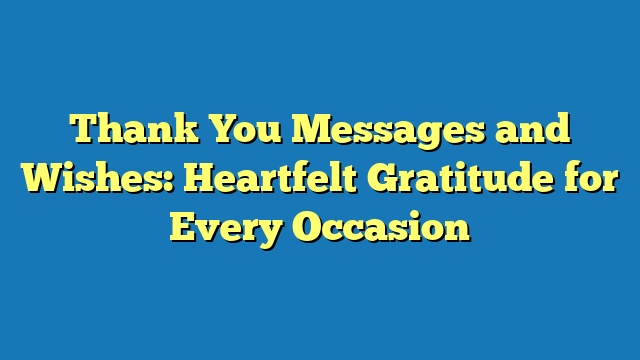“Thank you messages wishes” encompass heartfelt expressions of gratitude and well-wishes conveyed through written or spoken communication. For instance, a heartfelt thank you message might express appreciation for assistance rendered or a thoughtful gift received.
These messages play a crucial role in fostering connections, building relationships, and demonstrating appreciation. They convey sincerity, respect, and warmth, leaving a lasting positive impression on the recipient.
Historically, the practice of expressing gratitude dates back to ancient times, finding expression in diverse cultures and civilizations. In many societies, it was considered a virtue to express appreciation for acts of kindness or support, and this tradition continues to shape our social interactions today.
Thank You Messages Wishes
Expressions of gratitude and well-wishes, conveyed through written or spoken communication, play a crucial role in fostering connections, building relationships, and demonstrating appreciation. These messages take various forms, each with its own unique purpose and impact.
- Heartfelt: Sincere expressions of appreciation
- Well-wishes: Positive thoughts and hopes for the future
- Personal: Tailored to the recipient’s interests and experiences
- Formal: Traditional expressions of gratitude in professional settings
- Cultural: Reflecting societal norms and customs
- Written: Letters, cards, or online messages
- Spoken: Face-to-face conversations or phone calls
- Virtual: Electronic messages or social media posts
These aspects shape the effectiveness and impact of thank you messages and wishes. By understanding and considering these elements, individuals can craft meaningful expressions that leave a lasting positive impression on the recipient.
Heartfelt
Within the realm of “thank you messages wishes,” heartfelt expressions of appreciation stand out as a powerful means of conveying genuine gratitude and care. These sincere messages, crafted with thoughtfulness and authenticity, resonate deeply with recipients, strengthening bonds and leaving a lasting positive impression. Let’s delve into four key facets that define heartfelt expressions of appreciation in the context of “thank you messages wishes”:
- Personalization: Heartfelt expressions of appreciation are tailored to the unique qualities, experiences, and interests of the recipient. This level of personalization demonstrates that the message is not merely a generic response but rather a genuine acknowledgment of the individual’s value.
- Specificity: Effective expressions of appreciation avoid vague or general language, instead focusing on specific actions, gestures, or qualities that have been appreciated. By pinpointing the reasons for gratitude, the message conveys a sense of thoughtfulness and sincerity.
- Emotional Connection: Heartfelt expressions of appreciation tap into the emotional bond between the sender and recipient. They convey not only gratitude but also warmth, affection, and a deep sense of connection.
- Timeliness: The timing of heartfelt expressions of appreciation plays a crucial role in their impact. Expressing gratitude promptly demonstrates that the sender is attentive and values the recipient’s actions or presence in their life.
By incorporating these facets into “thank you messages wishes,” individuals can create heartfelt expressions that genuinely resonate with recipients, fostering stronger relationships and creating a positive and appreciative atmosphere.
Well-wishes
Within the spectrum of “thank you messages wishes,” well-wishes stand out as expressions of positive thoughts and hopes for the future. These messages convey optimism, support, and a belief in the recipient’s potential. They not only acknowledge past actions or gestures but also extend a sense of encouragement and anticipation for what lies ahead.
- Genuine Expression: Effective well-wishes are not mere platitudes but rather heartfelt expressions of hope and support. They convey a genuine desire for the recipient’s well-being and success.
- Specificity: Well-wishes can be tailored to the recipient’s specific goals, aspirations, or dreams. By expressing hopes that align with their interests and values, the message becomes more meaningful and impactful.
- Positive Outlook: Well-wishes focus on the positive aspects of the future, fostering a sense of optimism and hope. They encourage the recipient to embrace challenges, pursue opportunities, and believe in their own potential.
- Emotional Connection: Well-wishes create an emotional bond between the sender and recipient, conveying a sense of care and support. They remind the recipient that someone believes in them and is rooting for their success.
By incorporating these facets into “thank you messages wishes,” individuals can create well-wishes that resonate with recipients, uplift their spirits, and inspire them to reach for their goals. These messages serve as a reminder that even in the face of challenges, there is always hope and support to be found.
Personal
Within the realm of “thank you messages wishes,” personalization emerges as a critical component, elevating these expressions beyond mere formalities into heartfelt gestures that resonate deeply with recipients. Personalization involves tailoring the message to the unique interests, experiences, and values of the individual being thanked or wished well.
This level of customization lends a profound authenticity to the message, demonstrating that the sender has taken the time to reflect on the recipient’s individuality. It transforms the message from a generic acknowledgment into a thoughtful and meaningful expression of appreciation or well-wishing. By incorporating personal details, the sender conveys a genuine understanding of the recipient’s life and aspirations.
Consider a heartfelt thank-you message crafted for a close friend who has always been there through thick and thin. The message could recount specific instances where their presence made a significant difference, acknowledging their unique qualities and the positive impact they have had on the sender’s life. Such personalization imbues the message with a depth of emotion that transcends mere words, strengthening the bond between friends.
The practical application of this understanding extends to various settings, from personal relationships to professional interactions. By tailoring thank-you messages and well-wishes to the recipient’s interests and experiences, individuals can foster stronger connections, build rapport, and create a lasting positive impression. It demonstrates a level of care and attention that is often lacking in standardized or impersonal messages.
Formal
Within the diverse landscape of “thank you messages wishes,” formal expressions of gratitude occupy a distinct niche, serving as traditional and professional means of conveying appreciation in business and workplace environments. These messages adhere to established norms and etiquette, reflecting the structured and hierarchical nature of professional settings.
- Appropriate Language: Formal expressions of gratitude prioritize the use of polite and respectful language, adhering to conventional standards of grammar and avoiding colloquialisms or slang. This level of formality conveys professionalism and maintains a sense of decorum.
- Specific Acknowledgement: Effective formal thank-you messages clearly articulate the specific actions, contributions, or achievements being acknowledged. By pinpointing the reasons for gratitude, the sender demonstrates a genuine understanding of the recipient’s efforts and accomplishments.
- Professional Tone: Formal expressions of gratitude maintain a professional tone, avoiding excessive emotionalism or personal anecdotes. This tone reinforces the message’s professional nature and ensures that the focus remains on the expression of appreciation rather than personal relationships.
- Company Protocol: In some professional settings, established protocols dictate the format and content of formal thank-you messages. These protocols may include specific templates, preferred communication channels, or guidelines for expressing gratitude in a consistent and standardized manner.
By adhering to these facets, individuals can craft formal expressions of gratitude that are appropriate for professional settings, effectively conveying appreciation while maintaining a professional and respectful demeanor. These messages not only acknowledge contributions but also strengthen professional relationships and foster a positive work environment.
Cultural
Within the diverse tapestry of “thank you messages wishes,” cultural norms and customs play a significant role in shaping the expression and interpretation of gratitude. These cultural influences manifest in various aspects of thank-you messages and well-wishes, reflecting the social and societal context in which they are exchanged.
- Ritualistic Practices: In certain cultures, expressing gratitude may involve specific rituals or customs. These practices can range from bowing and offering gifts to performing symbolic gestures that convey appreciation.
- Language and Etiquette: Cultural norms dictate the appropriate language and etiquette used in thank-you messages. For instance, some cultures emphasize formal and respectful language, while others encourage a more casual and personal tone.
- Social Hierarchy: In societies with a strong emphasis on social hierarchy, the expression of gratitude may be influenced by the relative status of the sender and recipient. This can impact the choice of words, the formality of the message, and even the type of gift given.
- Religious or Spiritual Beliefs: Religious or spiritual beliefs can also shape the way gratitude is expressed. In some cultures, thank-you messages may incorporate religious symbols or references to divine beings.
Understanding the cultural context of thank-you messages and well-wishes is essential for effective communication. By considering the societal norms and customs that influence these expressions, individuals can craft messages that are respectful, appropriate, and meaningful within a specific cultural context.
Written
Written communication remains a prevalent and versatile medium for expressing gratitude through “thank you messages wishes.” This format allows for thoughtful and detailed expression, enabling the sender to convey their appreciation in a tangible and enduring way.
- Personalized Touch: Handwritten letters and cards exude a personal touch, signaling a genuine effort and care taken by the sender. The physicality of these messages adds a sentimental value, making them cherished keepsakes.
- Elaborate Expression: Written messages provide ample space for detailed expressions of gratitude. Senders can articulate their appreciation with nuance and specificity, conveying heartfelt sentiments that may be difficult to express verbally.
- Artistic Embellishments: Letters and cards often incorporate artistic elements such as drawings, stickers, or other embellishments. These visual enhancements add a creative and playful dimension, further personalizing the message.
- Timeless Nature: Unlike fleeting spoken words, written messages have a timeless quality. They can be revisited and cherished long after the initial exchange, serving as a lasting reminder of appreciation.
The written format of “thank you messages wishes” offers a unique combination of personal expression, thoughtful elaboration, and enduring value. Whether crafted as heartfelt letters, artistic cards, or thoughtful online messages, these written gestures convey gratitude in a tangible and meaningful way.
Spoken
Within the realm of “thank you messages wishes,” spoken expressions of gratitude occupy a unique space, leveraging the power of direct human interaction to convey heartfelt appreciation. These verbal exchanges, whether conducted face-to-face or over the phone, carry a distinct set of advantages and considerations.
- Immediate and Personal: Spoken thank-you messages have an immediate and personal quality, allowing for spontaneous reactions and genuine emotional connection. The tone of voice, facial expressions, and body language all contribute to the message’s impact.
- Nonverbal Cues: Face-to-face conversations offer the added layer of nonverbal cues, such as eye contact, gestures, and posture. These nonverbal signals can reinforce the verbal message, conveying warmth, sincerity, and respect.
- Real-Time Feedback: Spoken thank-you messages allow for real-time feedback, enabling the recipient to respond and express their appreciation directly. This interactive exchange fosters a sense of connection and mutual understanding.
- Cultural Influences: Cultural norms and expectations can shape the way gratitude is expressed verbally. In some cultures, face-to-face expressions of thanks are highly valued, while in others, written messages may be considered more appropriate.
Spoken expressions of gratitude, whether delivered face-to-face or over the phone, offer a unique and impactful way to convey appreciation. The immediacy, personal touch, and nonverbal cues associated with spoken communication enhance the emotional connection and strengthen the bonds between individuals.
Virtual
Within the realm of “thank you messages wishes,” virtual communication through electronic messages or social media posts has emerged as a prevalent and evolving medium for expressing gratitude. These digital platforms offer unique advantages and considerations that shape the nature and impact of thank-you messages.
- Convenience and Accessibility: Electronic messages and social media posts provide a convenient and accessible way to express gratitude, allowing individuals to convey their appreciation from any location with an internet connection.
- Multimedia Integration: Virtual platforms enable the incorporation of multimedia elements such as images, videos, or GIFs into thank-you messages. These elements can enhance the expressiveness and engagement of the message.
- Public or Private Expression: Social media platforms offer both public and private messaging options, allowing individuals to tailor the visibility of their thank-you messages based on their preferences and the nature of the relationship.
- Technological Advancements: Ongoing technological advancements are introducing new features and functionalities to virtual communication platforms, such as real-time video messaging and interactive emojis, which can further enhance the expression of gratitude.
The virtual realm of “thank you messages wishes” continues to evolve, offering individuals diverse and innovative ways to convey their appreciation. As technology advances and social media platforms introduce new features, the possibilities for expressing gratitude through virtual means will undoubtedly continue to expand.
Frequently Asked Questions about “Thank You Messages Wishes”
This FAQ section addresses commonly asked questions and clarifies key aspects related to “thank you messages wishes.” These questions aim to provide a deeper understanding of the topic and anticipate potential queries from readers.
Question 1: What is the difference between a “thank you” message and a “well-wish” message?
Answer: A “thank you” message expresses gratitude for a specific action or gesture, while a “well-wish” message conveys hope and support for the future. “Thank you” messages acknowledge past events, while “well-wish” messages look forward to positive outcomes.
Question 2: How can I personalize a “thank you” message?
Answer: Personalize “thank you” messages by mentioning specific details or qualities of the recipient. Focus on their unique contributions or the impact of their actions. Share a specific memory or anecdote that highlights your appreciation.
Question 3: What are some appropriate ways to express gratitude in a professional setting?
Answer: In professional settings, maintain a formal tone and use polite language. Express gratitude for specific accomplishments or contributions. Consider sending a handwritten note or a professional email. Adhere to any established company protocols for expressing appreciation.
Question 4: How can I express gratitude in different cultures?
Answer: Cultural norms and customs influence the expression of gratitude. Research or ask about appropriate gestures, language, or etiquette in different cultures. Be mindful of social hierarchies and religious beliefs that may shape the way gratitude is conveyed.
Question 5: What are the advantages of written “thank you” messages?
Answer: Written “thank you” messages provide a tangible and lasting record of appreciation. They allow for more detailed and thoughtful expression. Handwritten notes add a personal touch and can be cherished as keepsakes.
Question 6: How can I make a virtual “thank you” message more engaging?
Answer: Use multimedia elements such as images, videos, or GIFs to enhance the visual appeal of virtual “thank you” messages. Explore interactive features like video messaging or polls to make the message more engaging. Consider the platform and audience when choosing the appropriate format.
These FAQs provide a foundation for understanding the nuances of “thank you messages wishes.” Whether expressing gratitude in person, through writing, or virtually, it is essential to consider the context, audience, and cultural factors to convey appreciation effectively.
As we delve deeper into the topic, we will explore advanced strategies for crafting impactful thank-you messages and navigating challenging situations related to gratitude expression.
Tips for Crafting Effective “Thank You Messages Wishes”
This section provides practical and actionable tips to help you create meaningful and impactful “thank you messages wishes.” By following these guidelines, you can effectively express your gratitude and strengthen your relationships with others.
Tip 1: Be Specific: Express your appreciation for specific actions, gestures, or qualities. Avoid generic statements by highlighting the unique and meaningful aspects of the recipient’s contribution.
Tip 2: Be Sincere: Let your genuine gratitude shine through your message. Use heartfelt language and avoid sounding forced or obligatory.
Tip 3: Be Timely: Express your appreciation promptly to show that you value the recipient’s actions. A timely thank-you message demonstrates your attentiveness and consideration.
Tip 4: Choose the Right Medium: Consider the recipient’s preferences and the nature of your relationship when choosing the medium for your message. Written notes, emails, phone calls, or social media posts can all be effective.
Tip 5: Personalize Your Message: Tailor your message to the specific recipient by mentioning their unique qualities or experiences. This adds a personal touch and makes your gratitude more meaningful.
Tip 6: Proofread Carefully: Before sending your message, proofread it carefully for any errors in grammar, spelling, or punctuation. A well-written message conveys professionalism and respect.
Tip 7: Follow Up: If appropriate, follow up with the recipient after sending your thank-you message. This shows that you are genuinely interested in their well-being and that your appreciation is ongoing.
Tip 8: Embrace Cultural Sensitivity: Be mindful of cultural norms and expectations when expressing gratitude. Research or ask about appropriate gestures, language, or etiquette to ensure your message is well-received.
Summary: By incorporating these tips into your “thank you messages wishes,” you can create heartfelt expressions of appreciation that strengthen relationships, build goodwill, and leave a lasting positive impression on the recipient.
Transition to the Conclusion: These tips provide a solid foundation for crafting effective “thank you messages wishes.” In the conclusion, we will explore advanced strategies for expressing gratitude in challenging situations and discuss the overall importance of gratitude in our lives.
Conclusion
The exploration of “thank you messages wishes” in this article unveils the multifaceted nature of gratitude expression. Central to effective gratitude communication is the ability to craft thoughtful and meaningful messages that resonate with the recipient.
Key insights from this article include the importance of specificity, sincerity, timeliness, personalization, and cultural sensitivity in crafting effective “thank you messages wishes.” These elements contribute to messages that genuinely acknowledge and appreciate the actions or qualities of others, fostering stronger relationships and a positive social environment.
As we navigate an increasingly interconnected world, the significance of expressing gratitude cannot be overstated. “Thank you messages wishes” serve as powerful tools for building bridges, strengthening bonds, and creating a more harmonious society. Let us embrace the opportunity to cultivate a culture of gratitude, where heartfelt expressions of appreciation become the norm.









Tips for Using "Template by Kevin Crafts" Comments for Meaningful Online Discussions